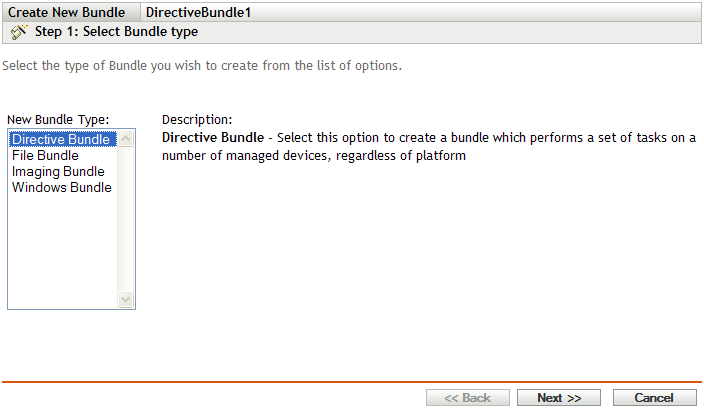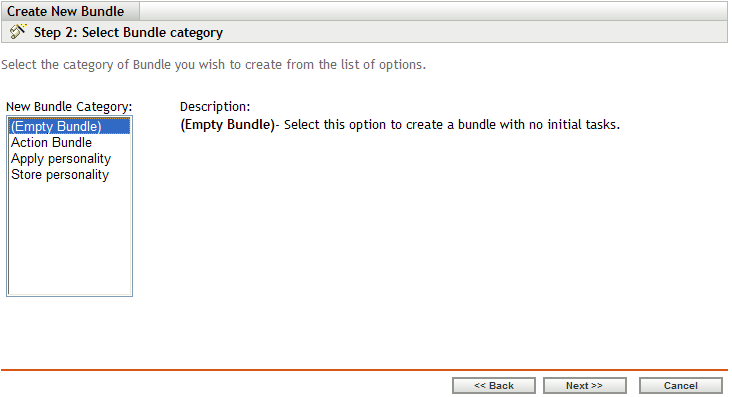2.1 Creating Directive Bundles
A Directive bundle lets you perform one or more actions on one or more devices, regardless of platform. For example, you can use a Directive bundle to edit a Windows INI file or text file. You can run a script, start or stop a service, delete a file, and more. In addition, the bundle includes various other actions and personality actions such as Store Personality and Apply Personality.
You can use ZENworks Control Center or the zman command line utility to create bundles. The following procedure explains how to create a bundle using ZENworks Control Center. If you prefer the zman command line utility, see Bundle Commands
in ZENworks Command Line Utilities
.
To create a Directive bundle:
-
In ZENworks Control Center, click the tab.
-
In the list, click , then click to display the Select Bundle Type page.

-
Select , then click to display the Select Bundle Category page.

-
Select the desired bundle category:
Empty Bundle: A bundle with no initial tasks. This bundle category is useful to quickly create a bundle without performing all of the tasks in the Create New Bundle Wizard. After you create the empty bundle, you can edit its details to add assignments, actions, and so forth, at a later time.
Action Bundle: A bundle with one or more actions.
Apply Personality: A bundle that applies the personality of one or more users on the managed device from a personality file stored on the local or network path.
Store Personality: A bundle that stores the personality of one or more users on the managed device to a personality file on the local or network path. The personality files are not uploaded to the ZENworks content repository.
-
Click to display the Define Details page, then fill in the fields.
Bundle Name: Provide a name for the bundle. The bundle name must be different than the name of any other item (bundle, group, folder, and so forth) that resides in the same folder. The name you provide displays in ZENworks Control Center and the ZENworks Adaptive Agent (on managed devices).
For more information, see
Naming Conventions in ZENworks Control Center
.Folder: Type the name or browse to and select the ZENworks Control Center folder where you want the bundle to reside. The default is /bundles, but you can create additional folders to organize your bundles.
Icon: ZENworks Configuration Management lets you select an icon that users see during installation of a particular bundle. This icon applies only to the icon displayed by the ZENworks Adaptive Agent on the managed device. ZCC uses default icons to represent the different bundles (Directive, File, Imaging, and Windows).
To select an icon, click , then browse to and select the icon you want to display on managed devices.
If the desired icon is embedded in a .exe, .dll, or .ico file that has multiple icons from which to choose, you must install additional items before you can browse to and select the desired icon.
For Mozilla Firefox, if you have not already installed the Novell File Upload extension on this device, you must do so before you can download and install the download plug-in or browse to and upload the icon. For more information, see Novell File Upload Extension. After you install the Novell File Upload extension, you must also install the download plug-in. To do so, click the message box that displays in the Select Icon dialog box (if you have already installed the plug-in on this device, the plug-in box does not display), click , then click .
For Microsoft Internet Explorer, you must install the Novell File Upload ActiveX control only; there is no download plug-in for Internet Explorer. For more information, see Novell File Upload Extension.
After you have downloaded and installed the necessary extensions and plug-in, click
 to browse to and select the icon you want the ZENworks Adaptive Agent to display to represent the bundle. If the icon is embedded in a .exe, .dll, or .ico file that contains multiple icons, an additional dialog box displays to let you select the desired icon.
to browse to and select the icon you want the ZENworks Adaptive Agent to display to represent the bundle. If the icon is embedded in a .exe, .dll, or .ico file that contains multiple icons, an additional dialog box displays to let you select the desired icon.
If you do not specify an icon, a default icon is used.
Description: Provide a short description of the bundle's contents. This description displays in ZENworks Control Center and in the ZENworks Adaptive Agent.
-
Click , then skip to the appropriate step, depending on which bundle category you chose in Step 4:
-
(Conditional) If you are creating an Action bundle, follow the wizard prompts until you reach the Summary page, then skip to Step 10.
Click for information about each page or refer to the following table:
Wizard Page and Field
Details
page >
Click , then click an action. Fill in the options in the dialog box that displays. Click the button if you need additional information.
page >
Select the check box next to the action (or actions) you want to remove. Click
page >
Select the check box next to the action (or actions) you want to move up. Click
page >
Select the check box next to the action (or actions) you want to move down. Click
page >
Select the check box next to the action (or actions) you want to enable. Click
page >
Select the check box next to the action (or actions) you want to disable. Click
page >
Click . Modify the desired settings, then click to return to the Add Actions page. Click the button if you need additional information.
page >
Select the check box next to the action (or actions) if you want to continue performing the remaining actions in the set on failure of the selected action. Select the check box in the column, then click .
-
(Conditional) If you are creating an Apply Personality action, follow the wizard prompts until you reach the Summary page, then skip to Step 10.
Click for information about each page or refer to the following table:
Wizard Page and Field
Details
Apply Personality page > field
Select this option and click
 to display the Upload Content dialog box. Browse to and select the template to upload.
to display the Upload Content dialog box. Browse to and select the template to upload.
Apply Personality page > field
Select this option to specify the path of the personality migration template file on the managed device. You can also specify the UNC path of the file.
Apply Personality page > field
Specify the path of the PNP file containing the migration settings and data on the managed device. You can also specify the UNC path of the file.
Apply Personality page >
Select this check box to enter the password to decrypt the PNP file.
If you spanned the PNP file, be sure to keep the spanned files and the PNP file in the same folder.
-
(Conditional) If you are creating a Store Personality action, follow the wizard prompts until you reach the Summary page, then skip to Step 10.
Click for information about each page or refer to the following table:
Wizard Page and Field
Details
Store Personality page > field
Select this option and click
 to display the Upload Content dialog box. Browse to and select the template to upload.
to display the Upload Content dialog box. Browse to and select the template to upload.
Store Personality page > field
Select this option to specify the path of the personality migration template file on the managed device. You can also specify the UNC path of the file.
Store Personality page > field
Specify the path of the PNP file on the managed device for storing the migration settings and data. You can also specify the UNC path of the file.
Store Personality page >
Select this check box to enter a password to protect the PNP file.
In the Re-enter the password field, re-enter the password to confirm it.
Store Personality page >
Select this option to span the personality migration data across multiple files to enable you to store data in removable media.
Select the option to migrate personalities without spanning the files.
Select the option to specify a span size for the files. The default span size is 650 MB.
-
Review the information on the Summary page, making any changes to the bundle settings by using the button as necessary.
-
(Conditional) Select the check box to display the bundle’s Summary page after the wizard completes. You can use the various tabs to edit the bundle’s assignments, system requirements, actions, settings, and content replication settings.
-
Click to create the bundle as configured according to the settings on the Summary page.
When you click Finish, the bundle is created but it does not have users or devices assigned, schedules, and group membership. At some point, you need to configure additional options for the bundle by continuing with Section 3.2, Assigning Existing Bundles to Devices or Section 3.3, Assigning Existing Bundles to Users.